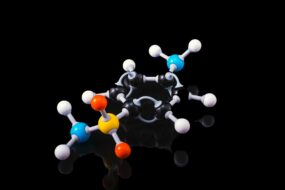Diclofenac sodium is an analgesic, antipyretic and anti-inflammatory drug.
It inhibits PG synthesis and, to some extent, selective COX-2.
The antiplatelet action is not appreciable due to the sparing of COX-1.
It also does not block the cardioprotective effect of low-dose aspirin. Neutrophil chemotaxis and superoxide production at the inflammatory site are reduced.
Mechanism of action.
· It Inhibits cyclooxygenase (COX)-1 and COX-2 activity, thereby inhibiting prostaglandin synthesis.
· Also inhibit neutrophil aggregation and activation,
· It inhibits chemotaxis action.
· It decreases proinflammatory cytokine levels and alters lymphocyte activity.
Clinical uses.
Used as an NSAID in :
- Rheumatoid and osteoarthritis
- Ankylosing spondylitis
- Toothache and dysmenorrhoea
- Renal colic and bursitis
- Posttraumatic and postoperative inflammatory conditions.
Adverse effects.
- Epigastric pain, nausea, headache, dizziness, rashes.
- Gastric ulceration and bleeding.
- Flatulence, heartburn, and dyspepsia.
- Edema
Drug interaction.
- Diclofenac increases levels of methotrexate by decreasing renal clearance.
- Ketorolac increases the toxicity of the drug by pharmacodynamic synergism.
Contraindication.
· Hypersensitivity, i.e., anaphylaxis, serious skin reactions.
· Asthma, urticaria, or other allergic-type reactions after taking aspirin or other NSAIDs.
Dosage.
- 50 mg TDS, then BD oral, 75 mg deep i.m.
- VOVERAN,DICLONAC, MOVONAC 50 mg enteric coated tab, 100 mg S.R. tab, 25 mg/ml in 3 ml amp. for i.m. injection.
- DICLOMAX 25, 50 mg tab, 75 mg/3 ml injection.
- DICLONAC, VOVERAN OPHTHA 0.1% eye drops.












